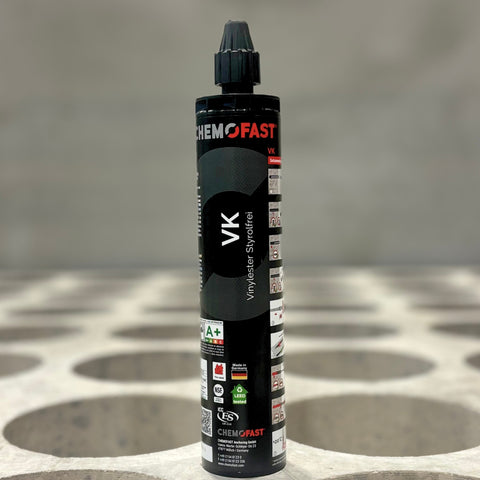Facade installation of solar panels
In addition to mounting the panels on the roof or installing a balcony power plant, attaching solar modules to the facade of a building offers a completely new way of using previously unused space and generating renewable energy. Until now, façade installation to generate sustainable energy was only possible in new buildings, as sensitive thermal insulation composite systems are often installed on the facade of renovated, older buildings. Because there was a risk of damaging the insulation and thus impairing the energy efficiency of the building, photovoltaic systems could not previously be attached to the facades. By installing the solar panels using a combination of injection mortar and spacer mounting system, these problems are history. With our injection mortars and our ResiTherm spacer mounting system, safe and approved installation of the solar panels in thermal composite systems is possible, without the formation of thermal bridges.
There are various injection mortar systems available that can be used in combination with the ResiTherm. It is important to consider the type of anchor base in which the spacer mounting system is installed. The following injection mortar systems have ETA approval with the ResiTherm:
Installation in masonry and aerated concrete
(before use, urgently determine the type of stone according to ETA)
- Chemofast VK or VK Nordic ETA-20-0557 - Masonry - Chemofast VK.pdf
- Chemofast VECO ETA-20-0051 - Masonry - Chemofast VECO.pdf
- Chemofast PASF ETA-12-0341 - Masonry - Chemofast PASF.pdf
- Chemofast EASF ETA-12-0536 - Masonry - Chemofast EASF.pdf
Installation in cracked and non-cracked concrete
- Chemofast VK or VK Nordic ETA-08-0237- Concrete - Chemofast VK.pdf
- Chemofast VECO ETA-19-0402 - Concrete - Chemofast VECO.pdf
Installation in uncracked concrete
- Chemofast PASF ETA-11-0285 - Concrete - Chemofast PASF.pdf
- Chemofast EASF ETA-12-0106 - Concrete - Chemofast EASF.pdf
- Chemofast EA ETA-12-0111 - Concrete - Chemofast EA.pdf
- Chemofast PA ETA-11-0286 - Concrete - Chemofast PA.pdf
Before installation, it must be ensured that the facade has enough load-bearing capacity for the solar panels and is in good condition (no mold or structural damage). Once this is guaranteed, the installation can begin.
Installation in concrete and solid brick is carried out in the same way. First, the borehole is created using the drilling method and drill bit dimension required by ETA. The borehole is then cleaned. The procedure is always blow out, brush and blow out. However, the number of processes differs depending on the injection mortar and anchor base. Afterwards, it is checked whether the pre-assembled threaded rod is the required length. If not, the threaded rod is sawn off to the desired length. Next, the mixer extension is screwed onto the mortar cartridge with the static mixer. Be careful with tubular film cartridges! Before the static mixer is attached, the tubular film must be cut off below the clip. The injection mortar is pressed out until the mortar has a uniform gray color and then the borehole is filled with the mortar. Afterwards, using a cordless screwdriver and a hexagon bit, the threaded rod and the ResiTherm are screwed into the borehole until the seal rests against the plaster. After the specified curing time, the mounting profiles/mounting rails can be installed. Pay attention to the maximum torque T inst from the ETA! Finally, the modules are attached to the mounting profiles/mounting rails.
In principle, the procedure for installation in perforated brick is the same as in concrete and solid brick. The difference is that after the cleaning process, a sieve sleeve is also pressed into the drill hole using a folding rule or similar. The sieve sleeve is then filled with mortar and the spacer installation system is installed. The associated installation parameters with the curing times can be found in the respective ETAs.
Installation instructions and approvals for the Chemofast ResiTherm:
Assembly instructions for the ResiTherm distance assembly system M12
Assembly instructions for the ResiTherm distance assembly system M16
Project reference
In this project, the Chemofast Resitherm spacer mounting system and the Chemofast VK injection mortar were used to attach the solar panels to the facade.






